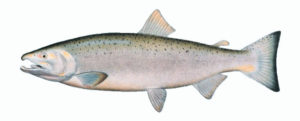 Well, these were surprising study results, given that so many studies find that eating fish has such beneficial health effects. A recent large study of US adults found that higher fish consumption was associated with melanoma (when compared to persons who hardly eat fish).
Well, these were surprising study results, given that so many studies find that eating fish has such beneficial health effects. A recent large study of US adults found that higher fish consumption was associated with melanoma (when compared to persons who hardly eat fish).
Brown School of Health researchers found that a higher intake of fish (all kinds), tuna, and non-fried fish were all associated with a higher risk of both malignant melanoma and melanoma in situ (stage 0). Interestingly, fried fish intake was inversely associated with risk of malignant melanoma - that is, the more fried fish is eaten, the lower the risk of melanoma.
The group with the highest fish intake ate about 10 ounces per week or 3 servings, and had about 22% higher rate of melanoma.
They speculate that this cancer association could be due to the contaminants in fish, such as PCBs, dioxins, arsenic, and mercury. Other research has found that higher fish intake is associated with higher levels of these contaminants in the body, and that there are associations between these contaminants and a higher risk of skin cancer.
But the researchers also said people should keep eating fish for all their other health benefits (e.g., for heart health). In other words, don't panic. There are other known risk factors for melanoma such as repeated sunburns in childhood.
From Science Daily: Higher fish consumption may be associated with increased melanoma risk
Eating higher levels of fish, including tuna and non-fried fish, appears to be associated with a greater risk of malignant melanoma, suggests a large study of US adults published in Cancer Causes & Control.
Eunyoung Cho, the corresponding author said: "Melanoma is the fifth most common cancer in the USA and the risk of developing melanoma over a lifetime is one in 38 for white people, one in 1,000 for Black people and one in 167 for Hispanic people1. Although fish intake has increased in the USA and Europe in recent decades, the results of previous studies investigating associations between fish intake and melanoma risk have been inconsistent. Our findings have identified an association that requires further investigation."
Researchers from Brown University, USA found that, compared to those whose median daily fish intake was 3.2 grams, the risk of malignant melanoma was 22% higher among those whose median daily intake was 42.8 grams. They also found that those whose median daily intake was 42.8 grams of fish had a 28% increased risk of developing abnormal cells in the outer layer of the skin only -- known as stage 0 melanoma or melanoma in situ -- compared to those whose median daily intake was 3.2 grams of fish. A portion of fish is approximately 140 grams of cooked fish.
To examine the relationship between fish intake and melanoma risk, the authors analysed data collected from 491,367 adults who were recruited from across the USA to the NIH-AARP Diet and Health Study between 1995 and 1996. Participants, who were aged 62 years on average, reported how frequently they ate fried fish, non-fried fish, and tuna during the previous year as well as their portion sizes.
The researchers calculated the incidence of new melanomas that developed over a median period of 15 years using data obtained from cancer registries. They accounted for sociodemographic factors, as well as participants' BMI, physical activity levels, smoking history, daily intake of alcohol, caffeine and calories, family history of cancer, and the average UV radiation levels in their local area. 5,034 participants (1.0%) developed malignant melanoma during the study period and 3,284 (0.7%) developed stage 0 melanoma.
The researchers found that higher intake of non-fried fish and tuna was associated with increased risks of malignant melanoma and stage 0 melanoma. Those whose median daily tuna intake was 14.2 grams had a 20% higher risk of malignant melanoma and a 17% higher risk of stage 0 melanoma, compared to those whose median daily tuna intake was 0.3 grams. A median intake of 17.8 grams of non-fried fish per day was associated with an 18% higher risk of malignant melanoma and a 25% higher risk of stage 0 melanoma, compared to a median intake of 0.3 grams of non-fried fish per day. The researchers did not identify significant associations between consumption of fried fish and the risk of malignant melanoma or stage 0 melanoma.
Eunyoung Cho said: "We speculate that our findings could possibly be attributed to contaminants in fish, such as polychlorinated biphenyls, dioxins, arsenic and mercury. Previous research has found that higher fish intake is associated with higher levels of these contaminants within the body and has identified associations between these contaminants and a higher risk of skin cancer. However, we note that our study did not investigate the concentrations of these contaminants in participants' bodies and so further research is needed to confirm this relationship."
The researchers caution that the observational nature of their study does not allow for conclusions about a causal relationship between fish intake and melanoma risk. They also did not account for some risk factors for melanoma, such as mole count, hair colour, history of severe sunburn and sun-related behaviours in their analyses. Additionally, as average daily fish intake was calculated at the beginning of the study, it may not be representative of participants' lifetime diets.
